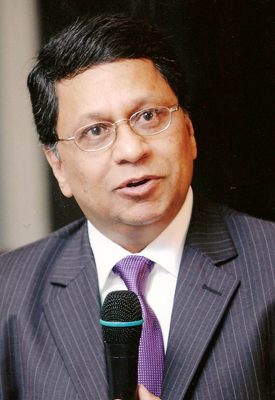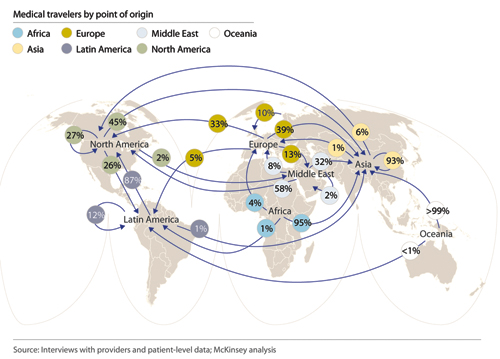Q&A: Quality, Safety, and Medical Tourism
July / August 2010
Q&A
Quality, Safety, and Medical Tourism
 Editor’s note:
Editor’s note:
After a long career as a clinician and medical informatics leader at the U.S. Department of Veterans Affairs, Syed Tirmizi, MD, grabbed his passport and joined Quantros as vice president of international business development. He had worked at the VA for over 20 years, serving first as chief of medicine/primary care at four teaching hospitals and later as a senior medical informatician in VA headquarters. Tirmizi is also an adjunct associate professor of health informatics at George Mason University in Virginia and may be contacted at stirmizi@quantros.com.
After returning from several trips to meet with hospital leaders in South Asia, the Middle East, and Western Europe, Tirmizi spoke to PSQH about the state of medical travel, particularly in South Asia, and the increasing global focus on hospital quality and safety.
Q: What are the biggest challenges to improvements in safety and quality in the Asian medical travel hospitals?
A: The biggest challenge is a lack of oversight and transparency in healthcare at the government level. The medical tourism hospitals increasingly are making an effort to meet international accreditation, quality, and patient safety standards. For example, the Quality Council of India is advocating NABH, the National Accreditation Board of Hospitals accreditation, though it is not a mandate at this time. Another challenge is the lack of optimal rehabilitation and follow-up after the patient returns to his or her country of origin.
Q: Which are the leading accreditors in Asia?
A: Some of the accreditation bodies are Joint Commission International, NABH, the Health Care Accreditation Council in Jordan, and ISO 9000.
Q: What patient safety programs or practices are ingrained in countries that are positioning themselves as leaders in medical tourism?
A: The programs that are ingrained relate to the move to electronic medical records and communication with the referring physician before, during, and after the procedure. India, the United Arab Emirates, Singapore, and other countries are very much into health information technology. It is only an enabler of better, safer, and more efficient care. Electronic medical records (EMRs) facilitate the development and monitoring of quality & patient safety measures.
Q: Are you seeing more investments in healthcare IT in hospitals you visit and if so, how are those advances affecting quality of care?
A: I’m seeing more hospitals migrating from paper to electronic health record systems, so you can easily put the relevant medical information or medical images on a thumb drive or on a CD-ROM, and have the patients bring that back home to share with their physicians. All the information should be there. The world is now indeed flat, and we need to make sure there is a health information exchange, not just across regions, but across countries and even continents. The data standardization effort is global. Both Microsoft Health Vault and Google Health are working on data transmission standards, as is HL-7.
Q: What do you see as the primary drivers for patients using Asian medical travel hospitals? How big an impact does international accreditation, such as Joint Commission International, play in the decision-making?
A: The principal driver is not JCI accreditation, but timely access to care for elective procedures and affordable care. Access would also include meeting the needs of the uninsured. Access in general in the United States isn’t that much of an influencing factor. Patients from the United Kingdom and Canada do travel for elective procedures—for example, knee replacement or hip replacement—because of the potential for delay in getting that care in their home countries. Regarding timely access to care, it really depends on the home country as to how much a driver that is to a patient. Medical tourism now is principally for elective procedures, cosmetic surgeries, and wellness and spas. The trend has also been to combine the medical care with sightseeing or relaxation after the procedure. Many of the medical tourism packages are promoting tourism after the patients have recovered from their procedures, particularly in countries with hospitals that specialize in cosmetic surgeries, such as Thailand, or now, South Africa. Prior to the World Cup tournament in South Africa this summer, I saw a promotion that suggested having a cosmetic procedure and staying on to watch the tournament.

Q. That’s innovative marketing, tying the World Cup to an opportunity for an elective medical procedure.
A. Yes, but even so, there are concerns about violence in South Africa and that is an issue that has limited medical tourism there. Along those lines, a factor that affects medical tourism worldwide is the political situation in the destination country and the country’s stability. Unfortunately for Thailand, for example, there has been political turmoil recently, and they’ve lost millions of dollars in medical tourism because some patients are reluctant to go there now.
Q: You’ve been touring hospitals and attending healthcare conferences in the Middle East, India, and Western Europe in just the past several months. How often are patient safety and quality of care discussed, and in what context?
A: I have noticed a heightened awareness at these hospitals of the importance of adopting best practices from the U.S. and Europe to further a culture of healthcare quality and patient safety. These issues are now high on the agenda at executive level meetings. Many hospitals have appointed quality and patient safety officers. That is a fairly new trend I’m seeing.
Q: It appears that in these so-called medical tourism countries, U.S. hospital management and safety policies are considered of high excellence, despite the fact that we know well the quality and safety shortcomings in many U.S. hospitals, as reported by the Institute of Medicine (IOM). True?
A: You’re absolutely right. It was kind of eye-opener in 1999 when the IOM’s To Err Is Human report came out, and then the Quality Chasm report in 2001, and the subsequent report, Leadership By Example. The very fact that an entity like the IOM did analyses like that, well, that has not happened yet, unfortunately, India, in Singapore, or Malaysia; hospital leaders in those countries are looking to learn from all the lessons of the IOM reports.
Q: How are medical tourism services offered in this day in age of Internet-based services? Just in the U.S. alone there are challenges to developing a unified system to rank the “best hospitals.” How can consumers get to a global ranking?
A: In the future, there will be online services — similar to Priceline — to allow global patients to pick their medical care worldwide from a list that includes price, offerings, quality rankings, etc. Most patients that travel for medical tourism want to check what services are offered and often check with others who may have traveled for the same. Increasingly the patients will use some of these services and bid for packages at their preferred location. Some hospitals may guarantee a pleasant and uncomplicated experience. Some of the insurance companies in these countries are teaming up to offer such a service as well. This will continue as a trend. In terms of developing useful quality ratings criteria, that will take some time, but there are a few steps being taken in this direction. WHO does look at accredited medical schools as well as hospitals. Joint Commission International is developing core measures for hospitals across the world, similar to what they have in the U.S. You see accrediting bodies in individual countries, like India and Jordan, moving toward collecting comparative data and making that information available for medical tourism patients to research hospitals online. You will see the country, the types of hospitals, information on whether they’re accredited by an international body or a local body, what are the standards of care. Currently, there’s not as much transparency in these kinds of areas as there is in the U.S. However, countries are moving in that direction of more transparency in pricing and clinical outcomes.
Q: It’s believed that medical travel will grow again as global economies improve. Is that bad news for U.S. hospitals? Why or why not?
A: No, it’s not bad news for U.S. hospitals. With the 35 million or so Americans who will be newly covered through recently passed healthcare reform, many will not have to travel since they will now get care in the U.S. In spite of the healthcare reform, there will be a need for medical travel for quicker and more affordable access. Many patients will find the co-payments not affordable and they will get faster care at medical tourism hospitals.
